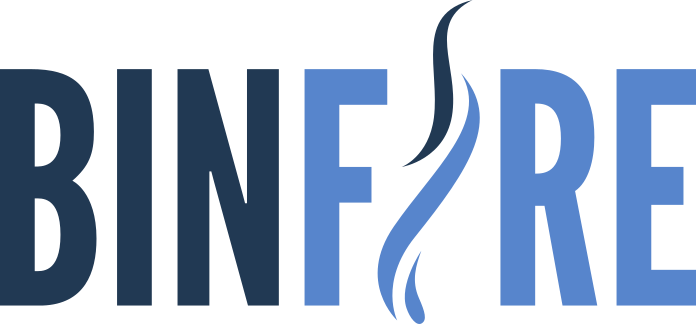You’ve finally found a senior backend engineer who’s perfect for your team. They understand distributed systems, they’ve shipped production code at scale, and they actually enjoy writing documentation. There’s just one problem: they live in Poland, and your startup is based in San Francisco.
Ten years ago, this would mean months of legal work, expensive entity setup, and maybe abandoning the hire altogether. But today? You could have them onboarded and productive in less than a week using an Employer of Record service.
The tech talent war isn’t just competitive—it’s global. The best developers, designers, and product managers aren’t concentrated in Silicon Valley anymore. They’re in Kraków, Buenos Aires, Bangalore, and Toronto. If you’re limiting your search to one country, you’re fishing in a puddle while your competitors are working the ocean.
EOR services let you hire anyone, anywhere, without setting up foreign entities or becoming an expert in international labor law. For cash-strapped startups racing to find product-market fit, that’s not just convenient—it’s often the difference between landing top talent and watching them accept an offer from a bigger, slower company.
We evaluated these five EOR providers through a startup lens: how fast can you onboard? What’s the real cost? Will your engineering team actually use the platform? Can it scale from five employees to fifty without breaking? Here’s what matters most:
Why Tech Startups Are Embracing EOR for Global Talent
Software engineering is borderless work. A developer in Argentina writes the same React code as someone in Austin. Product managers run standups over Zoom regardless of time zone. Design collaboration happens in Figma whether you’re in London or Lagos.
But hiring internationally? That’s where things get complicated fast. Or at least, they used to.
Traditional tech hubs have a supply problem. There are only so many experienced engineers in the Bay Area, and everyone from Google to the latest YC batch is competing for them. Salaries have skyrocketed. Median engineer compensation in San Francisco tops $180,000, and that’s before equity and benefits. For an early-stage startup burning through a seed round, those numbers get uncomfortable quickly.
Meanwhile, you can find exceptional senior engineers in Warsaw making $70,000 who are just as talented, just as motivated, and honestly, often more loyal because they’re not getting recruited away every three weeks. Same story in São Paulo, Lisbon, Ho Chi Minh City, and dozens of other emerging tech hubs building world-class engineering talent.
The cost difference isn’t about exploiting wage gaps—it’s about market realities. Cost of living in Medellín is different than Manhattan. When you hire globally, you’re paying competitive local rates while saving compared to Silicon Valley’s inflated market.
More than cost savings, though, EOR services solve the speed problem. When you find a great candidate, you need to move fast. If it takes you three months to set up a Polish entity while your competitor uses an EOR to onboard in a week, you lose the hire. In startup world, speed is everything.
EOR also fits perfectly with the lean startup philosophy. Why spend $25,000+ setting up and maintaining a legal entity in a new country when you’re making your first hire there? What if the market doesn’t work out? What if that hire doesn’t work out? EOR lets you test markets and make strategic bets without massive upfront investment.
This is “hire first, expand later” thinking. Start with EOR, validate the market by actually building a team there, then decide if entity setup makes sense once you’ve got 15-20 people. You’re not committing to expensive infrastructure before you know it’s worth it.
Key Factors for Evaluating EOR Services as a Tech Startup
When you’re evaluating EOR providers, generic comparison charts aren’t that helpful. “Enterprise-grade compliance” and “white-glove service” sound nice, but what do they actually mean for a Series A startup with eight people and eighteen months of runway?
Here’s what actually matters when you’re making this decision:
Speed of onboarding is table stakes. Your average time-to-hire in tech is already 30+ days. If your EOR adds another month of paperwork on top of that, you’re losing candidates. The best providers can get someone from signed offer to first paycheck in under a week. This isn’t a nice-to-have—it’s often the deciding factor in competitive offers.
Pricing transparency saves you from nightmare budget conversations with your CFO. Some EOR providers hit you with deposit requirements (tie up $50,000 in cash before making a single hire), FX markups (skim 3-5% on every payment), and mysterious “compliance fees” that appear later. When you’re managing burn rate down to the week, surprises kill you. You need clear, predictable monthly costs you can forecast.
Tech stack integration determines whether this becomes another admin headache or actually saves time. Does it have an API your engineering team can work with? Does it sync with your HRIS? Can you get Slack notifications for approvals? If your people ops person is copy-pasting data between systems, you picked wrong.
Developer experience matters more than most companies realize. Your EOR platform is where your employees check pay stubs, request time off, and access benefits. If it looks like it was designed in 2008 and requires three support tickets to update a banking detail, that’s a bad look. Your team notices this stuff, especially technical teams who expect modern, intuitive software.
Country coverage needs to match your hiring strategy. Some providers are strong in Latin America but weak in Asia. Others cover 170+ countries but handle some through third-party partners (which adds complexity). Make sure they have actual, owned entities in the markets you’re hiring from—or plan to hire from soon.
Compliance and risk is why you’re using an EOR in the first place, but the quality varies wildly. You want a provider that actually owns their entities (not reselling someone else’s), employs local legal experts, and updates their systems when labor laws change. If you end up liable for misclassification or tax issues, the EOR isn’t doing its job.
Customer support becomes critical the moment something goes wrong—and in global payroll, something always goes wrong eventually. Is support 24/7 or business hours in one time zone? Are you talking to knowledgeable humans or going through a chatbot maze? For startups, responsive support isn’t a luxury. When your engineer in Indonesia hasn’t been paid, you need answers now, not in 2-3 business days.
Scalability determines whether you’re solving this problem once or twice. Can the platform handle going from five employees to fifty? Can you add new countries easily? What happens when you’re ready to set up your own entity—do they support migration? Pick a solution that grows with you.
We evaluated these five providers specifically through this startup lens, testing each on real scenarios: hiring a senior engineer in Poland, onboarding a product designer in Brazil, paying a distributed team across eight countries. We checked pricing pages (verified March 2024), read recent reviews from tech companies specifically, tested onboarding flows, and talked to customers at different startup stages.
Borderless AI: AI-Powered EOR Built for Scaling Tech Teams
If you’re a technical founder who gets frustrated by slow, manual processes, Borderless AI is built for you. This is the EOR that actually uses AI in meaningful ways—not just as marketing speak, but to genuinely speed up everything from contract generation to compliance checks.
The company was founded in 2022 specifically to solve the problems tech startups face when scaling globally. Rather than building another traditional EOR with AI bolted on afterward, they designed the entire platform around automation and speed from day one.
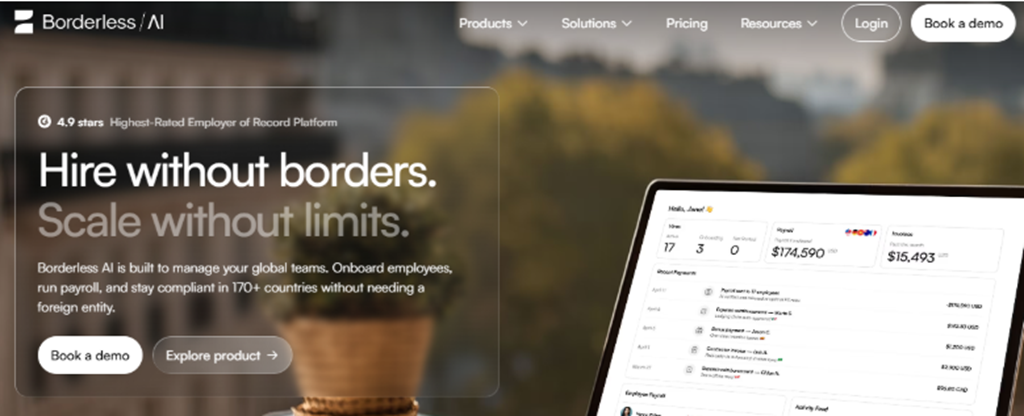
Why Tech Startups Choose Borderless AI
Industry-leading speed matters when you’re competing for talent. Borderless AI processes payroll in five days, which is genuinely the fastest in the market. When you’re trying to close a senior engineer who has three other offers, telling them “you’ll be fully onboarded and see your first paycheck next Friday” beats “it’ll take 3-4 weeks to process everything.” That speed advantage wins hires.
Zero upfront deposits preserve your runway. Most EOR providers require you to pre-fund salary payments—sometimes holding $50,000 or more in escrow before you can even make a hire. When you’re managing an eighteen-month runway and every dollar counts, tying up that much cash feels irresponsible. Borderless AI doesn’t require any pre-funding. You pay a flat monthly fee and that’s it. This alone can be a dealbreaker for early-stage companies watching burn rate.
The AI-native platform actually reduces admin work. Their HRGPT tool isn’t a gimmick—it’s a chat interface where you can ask questions like “what are statutory benefits requirements in Poland?” and get immediate, accurate answers. The Contract Generator uses AI to create localized employment agreements in minutes instead of days. For lean teams where the founder is still doing HR, this time savings adds up fast.
170+ countries means you’re not constrained geographically. Whether you’re hiring in established markets (UK, Germany, Canada) or emerging tech hubs (Vietnam, Colombia, Kenya), they have actual owned entities ready to go. You’re not waiting for them to set up a new country or dealing with third-party partnerships that add complexity.
Transparent pricing with no hidden costs makes financial planning possible. The monthly fee is clear, there are no FX markups on currency conversion, and you’re not getting surprised by random “compliance fees” or “administrative charges.” When your board asks about international hiring costs, you can give them a straight answer.
Modern API and integrations matter if you’re a technical team. Borderless AI has a real API that developers can work with, plus integrations with common HRIS tools. Your engineering team can build workflows that actually make sense instead of manually updating data in five different systems.
North America-based 24/7 support means when something urgent comes up, you’re talking to someone who understands startup pace and pressure. They’re not outsourced to a call center reading from scripts—they’re actual experts who can help you think through complex situations.
Developer-friendly experience shows up in the details. The platform interface is intuitive, your employees have a clean self-service portal, and the whole system feels like it was designed by people who actually use modern software. When your engineering team is used to tools like Linear and Notion, a clunky 2012-era interface stands out (in a bad way).
Compare that to setting up a Polish entity from scratch: 2-3 months minimum, $15,000-25,000 in legal and registration costs, plus ongoing accounting and compliance overhead. Or using a slower EOR that requires three weeks of paperwork and $30,000 sitting in escrow. The speed difference is a competitive advantage.
Borderless AI Pricing for Startups
Borderless AI uses straightforward monthly pricing per employee with no upfront deposits or hidden fees. Specific pricing varies by country and employee setup, but the structure is transparent from the start.
The key differentiator: zero pre-funding requirement. While competitors might ask for $20,000-50,000 in escrow, Borderless AI just charges a monthly service fee. When you’re managing cash flow carefully, that difference matters enormously.
Total cost of ownership is worth calculating. Entity setup in a new country costs $15,000-25,000 upfront plus $3,000-5,000 annually for compliance and accounting. If you’re making 1-5 hires in that country, EOR is dramatically cheaper. Even at 10-15 employees, the breakeven point depends on how long you plan to maintain that presence.
For financial planning, the monthly fee model is predictable. You can forecast exactly what international hiring will cost over the next 12-18 months without worrying about surprise charges. That predictability is valuable when you’re presenting hiring plans to your board.
Borderless AI Pros and Cons
Pros:
Fastest payroll processing solves the competitive hiring problem. Five days from contract to payment means you can move as quickly as your candidate needs you to. When you’re competing against well-funded companies, speed often matters more than a slightly higher salary.
Zero pre-funding preserves startup capital. That $50,000 sitting in an escrow account could be two months of runway. Using it for actual growth instead of parked deposits makes a real difference to early-stage companies.
AI automation cuts down on administrative burden. For small teams where the founder or a single operations person is handling HR, the time savings from AI-generated contracts and instant compliance answers adds up to hours per week.
4.9 G2 rating with exceptional support means you’re not alone. When issues come up (and they will), having responsive, knowledgeable people who understand startup urgency is worth its weight in gold.
Modern platform your team will actually use. This matters more than you’d think. If your benefits platform is painful to navigate, your employees associate that friction with working at your company.
Transparent pricing enables accurate financial planning. Your CFO (or you, playing CFO) can forecast international hiring costs confidently without padding estimates to account for unknown fees.
Strong compliance infrastructure without needing a legal team. They own their entities in 170+ countries and employ local legal experts. You’re protected without having to become an expert in Vietnamese labor law.
Continuous innovation in AI features. The platform is actively improving, with new automation and tools launching regularly based on customer feedback.
Cons:
Newer brand compared to legacy players. If your board or legal counsel is conservative and wants the “safe” choice with the longest track record, you might face internal resistance. The counterargument: newer technology built for modern startups vs. legacy systems retrofitted with AI as an afterthought.
Focuses on tech-forward companies. If your startup is in a more traditional industry or your team isn’t comfortable with AI-assisted tools, you might not get the full value. This is optimized specifically for fast-moving tech companies.
Premium positioning justified by features. Borderless AI isn’t the absolute cheapest option (that’s Horizons). But when you account for zero pre-funding, faster hiring, and time saved on administration, the total value often exceeds budget alternatives.
Lano: Flexible EOR with Multi-Country Coordination
Once you’re past the early scramble of making your first few international hires and you’re actually managing teams across six or eight countries, the complexity shifts. You’re not just trying to onboard fast anymore—you’re trying to coordinate payroll cycles, maintain compliance across different legal systems, and get visibility into your total international headcount without building a dozen spreadsheets.
That’s where Lano shines. Founded in 2018, they’ve built their platform around the specific challenges of managing distributed teams across multiple established markets.
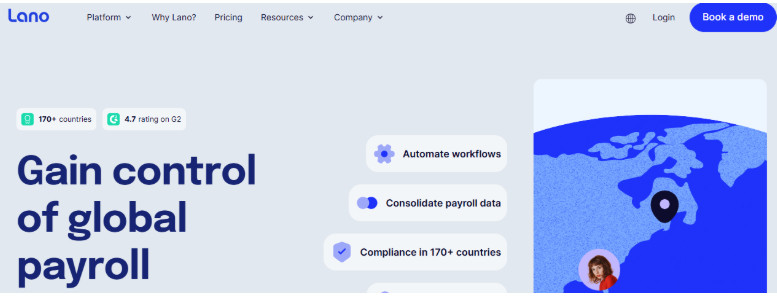
Why Tech Startups Choose Lano
Multi-country consolidation becomes critical at scale. When you have three people in Germany, five in Poland, two in Spain, and four in the UK, managing four separate EOR relationships (or worse, four separate entities) turns into a mess. Lano gives you a unified dashboard where you can see everyone, handle payroll for all countries at once, and manage compliance from one place. For a VP of People Operations juggling this complexity, that consolidation saves hours every week.
170+ countries with particularly strong European coverage makes them a natural fit if you’re building teams across EU tech hubs. They understand the nuances of German works councils, Polish employment contracts, Portuguese visa sponsorship, and Dutch payroll tax. That regional expertise shows up when you’re dealing with country-specific edge cases.
Compliance-first approach with AI-assisted auditing means they’re constantly checking that contracts, benefits, and tax withholdings match local requirements. As labor laws change (and they do, constantly), Lano’s system flags potential issues before they become problems. For companies worried about compliance risk, this proactive approach provides peace of mind.
HRIS integrations work with your existing tech stack. If you’re already using BambooHR, Personio, or similar tools, Lano syncs with them so you’re not maintaining duplicate records. Your people data lives in one place, payroll flows automatically, and your ops team isn’t spending time on manual data entry.
Contractor + employee management in one platform handles the reality that most growing startups have a mixed workforce. You might have contractors in five countries and full-time employees in three others. Managing both types through one provider simplifies things significantly compared to using different services for contractors vs. EOR.
Here’s a practical scenario: You’re a Series A startup that’s raised $12M and you’re ready to expand seriously into Europe. You want to hire across Berlin, Amsterdam, Lisbon, and Warsaw to access different talent pools and get 24-hour timezone coverage. You’re making 15-20 European hires over the next six months.
Lano lets you onboard all of them through one platform, run monthly payroll for everyone at once, and get consolidated reporting on headcount and costs. When your CFO asks “what’s our total European payroll burden?”, you can pull a single report instead of consolidating data from multiple sources.
Lano Pricing for Startups
Lano’s pricing varies by country and employee setup. They’re transparent about costs during the sales process, though not all pricing is publicly listed on their website.
They offer startup-friendly features like flexible payment terms and the ability to scale up or down as hiring plans change. For companies with multi-country needs, their pricing often includes volume considerations—the per-employee cost may decrease as you add more people.
Check directly with their sales team for specific pricing in your target countries and ask about any current startup programs or discounts for early-stage companies.
Lano Pros and Cons
Pros:
Strong European presence ideal for EU-focused expansion. If your growth strategy centers on European tech hubs, Lano’s regional expertise and entity network are hard to beat.
Consolidation features simplify multi-country operations. One dashboard, one point of contact, unified reporting—when you’re managing complexity, simplification is valuable.
Solid compliance and auditing tools give you confidence that you’re handling local labor law correctly across different jurisdictions.
Reasonable contractor management capabilities mean you can handle your mixed workforce without needing separate platforms.
Integrates with popular HRIS platforms so you’re not creating another data silo.
Established player with startup DNA means they understand the growth trajectory and changing needs as you scale.
Cons:
May have more complexity than early-stage startups need. If you’re making your first two international hires, Lano’s multi-country features might be overkill. The platform is built for coordination across many markets.
Pricing can be less transparent than pure-play startups. Country-specific quotes mean you need to go through sales conversations to understand costs, rather than seeing clear pricing upfront.
More traditional interface compared to modern alternatives. The platform is functional and professional, but it doesn’t have the sleek, intuitive UX that newer providers offer.
Horizons: Budget-Conscious EOR for Early-Stage Startups
Let’s be direct about money. When you’re a pre-seed startup with $800K in the bank and an eighteen-month runway, every dollar you spend on overhead is a dollar you’re not spending on product development or customer acquisition. You need international hiring capability, but you can’t justify premium pricing when you’re making your first one or two hires abroad.
Horizons gets this. Their whole positioning is straightforward, transparent, no-frills EOR services at competitive prices.
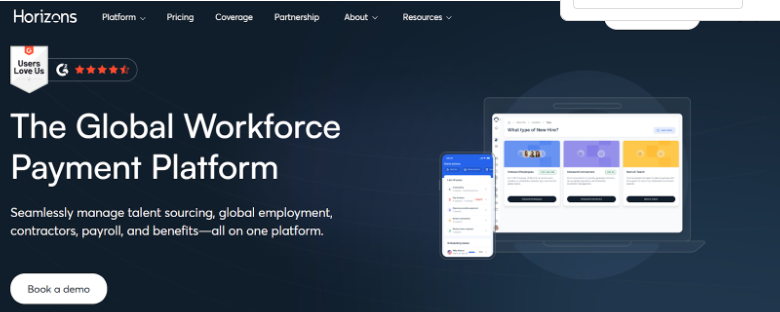
Why Tech Startups Choose Horizons
Competitive pricing starting at $299/month per employee is genuinely the most affordable you’ll find for full EOR services. When you’re comparing quotes and one provider wants $599/month while Horizons charges $299, that $300 difference compounds quickly. For a five-person international team, you’re saving $18,000 annually—enough to hire another contractor or extend your runway by a month.
180+ countries with particularly strong contractor payment coverage means you can hire almost anywhere. If your strategy is testing multiple markets with contractors first, then converting the best ones to full-time through EOR, Horizons handles both sides affordably.
Straightforward approach focused on essentials means you’re not paying for features you don’t need. There’s no AI chat assistant, no fancy analytics dashboard, no white-glove strategic consulting. You get compliant employment contracts, accurate payroll, and local benefits administration. That’s it. For bootstrapped founders or cash-conscious seed companies, that simplicity is a feature, not a bug.
Transparent pricing with clear cost structure means no surprises. They publish pricing publicly, they’re upfront about any fees, and you know exactly what you’ll pay before signing anything. When you’re building your hiring budget, that clarity is valuable.
Combined EOR + contractor management in one platform gives you flexibility as your hiring strategy evolves. Start with contractors in three countries, convert two to full-time employees, add more contractors in different markets—Horizons handles all of it without needing different providers.
Horizons Pricing for Startups
Starting at $299/month per employee for EOR services, with clear pricing published on their website. Contractor payments have different fee structures, typically percentage-based.
The all-in cost (service fees + salary + benefits) is typically 30-40% less than premium providers when you’re hiring in most countries. For early-stage companies where budget is the primary constraint, that difference matters.
No pre-funding requirements or salary deposits mean you’re not tying up capital. Pay the monthly service fee and the employee’s salary—nothing extra.
Horizons Pros and Cons
Pros:
Most transparent, competitive pricing in the market. When every dollar counts, $299/month vs. $599/month is a meaningful difference.
Perfect for startups watching every dollar. The value proposition is clear: compliant international hiring at the lowest cost.
Strong contractor management features give you flexibility to test markets before committing to full-time hires.
Wide geographic coverage means you’re rarely blocked by country availability.
Straightforward, no-surprises approach to service delivery. You know what you’re getting.
Publicly published pricing makes budgeting and decision-making easier.
Cons:
Fewer advanced features than premium options. No AI assistance, less sophisticated platform, more basic analytics and reporting.
May require more manual administrative work. Without automation, your ops person (or you) will spend more time on routine tasks.
More traditional platform experience. The interface is functional but not particularly modern or delightful to use.
Less hand-holding and strategic guidance. You’re getting transactional service, not consultative partnership.
Teamed: Remote-First EOR for Distributed Tech Teams
Remote work isn’t just a pandemic response anymore—for many tech startups, it’s a core value and competitive advantage. You’re not “allowing” remote work, you’re building a fully distributed company from day one. Your engineering team spans three continents, your product team works asynchronously, and you’ve never had an office.
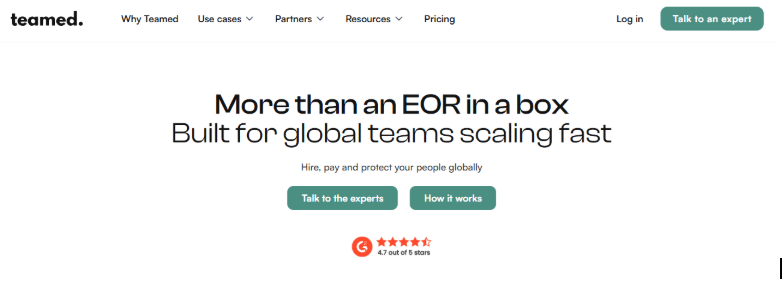
If that’s your company, you need an EOR that actually understands remote-first culture, not just one that can technically support it.
Teamed was built specifically for this. They’re not adapting traditional employment practices to remote work—they designed everything around distributed teams from the start.
Why Tech Startups Choose Teamed
Remote-first philosophy means they actually understand how distributed companies operate. Traditional EORs are built around assumptions of office-based work with remote as an exception. Teamed assumes remote is the default and designs accordingly. That philosophical difference shows up in their processes, their communication, and their platform.
Async-friendly processes respect different time zones and work schedules. Everything is designed so people don’t need to be online simultaneously. Document-first workflows, clear written processes, and systems that work whether you’re in New York or New Zealand. For engineering teams practicing async communication, this alignment matters.
Strong self-service capabilities empower remote employees to handle their own HR needs without depending on someone in a specific office during specific hours. Update banking information at 11 PM? Request time off on Sunday? Check your pay stub details while traveling? The platform supports autonomy instead of creating dependencies.
Developer-friendly approach shows they understand technical teams. The platform feels like it was designed by people who’ve worked at remote-first tech companies. Clean interface, logical flows, respect for user time and attention.
Focus on employee experience recognizes that in remote companies, every interaction with HR and payroll systems contributes to how people feel about working there. When your employees are distributed and you’re not building culture through office perks, the operational experience matters more.
Here’s where Teamed excels: You’re building a fully remote engineering team across the US, Europe, and Asia. Your CTO is in California, your senior engineers are in Poland and Vietnam, your DevOps lead is in Brazil. You work asynchronously—standups are written updates, documentation is thorough, and people contribute across a 16-hour timezone spread.
Teamed handles the EOR side with systems designed for this exact setup. When your engineer in Hanoi needs to request parental leave, she can do it through the self-service portal without waiting for anyone. When your team lead in Warsaw needs to verify salary details for an offer, the information is accessible immediately. Your operations flow doesn’t require anyone to be online at the same time.
The platform also helps with remote-specific challenges like equitable benefits across countries, managing different leave policies, and ensuring consistent employee experience despite geographic distribution.
Teamed Pricing for Startups
Teamed’s pricing varies by country and employee setup. They focus on providing value specifically to remote-first companies with their async-friendly workflows and self-service capabilities.
Pricing discussions happen directly with their team, who can provide quotes based on your specific country needs and team size. They understand the remote-first budget constraints and offer flexible arrangements.
Teamed Pros and Cons
Pros:
Deep understanding of remote work dynamics sets them apart from providers who treat remote as an afterthought.
Good employee self-service capabilities reduce administrative burden and empower team members.
Aligns with remote-first startup culture philosophically, not just operationally.
Focus on developer and technical team experience means the platform doesn’t frustrate your engineers.
Understands async communication needs and builds processes accordingly.
Strong documentation and written processes support remote workflows.
Cons:
Smaller country coverage than larger providers. While they cover key markets, they may not have entities everywhere you eventually want to hire.
Specialized focus may limit some traditional EOR features. They excel at remote-first scenarios but may have fewer features for companies with hybrid or office-based needs.
Less established brand awareness compared to more prominent EOR providers.
Potentially longer onboarding timelines than the fastest providers (typically 7-14 days).
Plane: Unified Payroll Platform for Contractor-Heavy Tech Startups
Most tech startups don’t start with a clean “we’re hiring employees in these three countries” strategy. Reality is messier. You have six contractors in different countries, two full-time employees in Canada, one person you just converted from contractor to employee in the UK, and you’re about to hire someone in Brazil but you’re not sure yet if it’ll be contractor or full-time.
Managing this through multiple platforms—one for US payroll, another for contractors, a third for EOR—creates administrative chaos. Plane solves this by handling everything in one system.
Why Tech Startups Choose Plane
Unified contractor + employee platform means one system for all worker types. Whether someone is a 1099 contractor in California, an independent contractor in Colombia, or a full-time EOR employee in Germany, they’re all in Plane. One dashboard, one set of workflows, one source of truth for your entire global team.
240+ countries for contractor payments is industry-leading coverage. Basically anywhere you might want to hire a contractor, Plane can handle it. For startups that start by testing markets with contractors before committing to full-time hires, this flexibility is valuable.
100+ countries for EOR services covers all the major tech talent markets plus most emerging hubs. The combination of contractor + EOR coverage means you’re rarely blocked by geography regardless of how you want to structure the relationship.
Automated payments with set-it-and-forget-it payroll reduces operational burden. Set up the payment schedule once, and Plane handles the rest—including currency conversion, local tax compliance, and payment delivery. For small teams managing distributed workforces, this automation saves hours every month.
US W2 payroll included in the same platform is surprisingly rare. Most EOR providers focus on international and tell you to use someone else for domestic payroll. Plane handles both, which means your entire company payroll—domestic employees, international employees, and contractors everywhere—lives in one place.
Human support with real people, not chatbots makes a difference when you’re dealing with complex situations. Plane emphasizes that you’re talking to knowledgeable humans who can actually help problem-solve, not getting stuck in automated response loops.
Transparent pricing with no hidden FX markups addresses a common pain point. Some platforms skim 3-5% on currency conversion without clearly disclosing it. Plane is upfront about their FX rates and doesn’t mark them up beyond actual costs.
Here’s a scenario where Plane really shines: You’re a Series A startup with 30 total people. You have 12 full-time employees in the US (W2), 8 international contractors (Argentina, Philippines, Poland, India), 6 full-time international employees through EOR (UK, Germany, Canada), and 4 part-time contractors in the US.
Without Plane, you’re using: Gusto for US payroll, Deel or Remote for some contractors, an EOR for international employees, and maybe PayPal or Wise for other contractor payments. Every pay cycle, you’re updating four different systems, reconciling payments across platforms, and your finance person is building spreadsheets to track everything.
With Plane, everyone’s in one platform. You run payroll once, it handles distribution to all worker types across all countries, and you get unified reporting. When your CFO asks “what’s our total global comp expense this quarter?”, you pull one report instead of aggregating from multiple sources.
Companies like AngelList, Help Scout, and PadSplit use Plane for exactly this reason—they have complex, distributed workforce structures and need one system that handles everything. The testimonials consistently mention how much time the consolidation saves and how much cleaner their financial reporting becomes.
Plane Pricing for Startups
Plane’s pricing varies based on your specific mix of contractors, W2 employees, and EOR employees. They’re transparent during the sales process about costs, though specific pricing isn’t fully public due to the customized nature of each setup.
The value proposition focuses on consolidation savings: instead of paying fees to multiple providers, you pay Plane. The total cost is often competitive because you’re not stacking platform fees.
They emphasize transparency around FX rates and fees—no hidden markups or surprise charges. For financial planning, knowing exactly what you’ll pay for each worker type helps budget accurately.
Plane Pros and Cons
Pros:
Best-in-class unified contractor + employee experience. This is genuinely the most seamless way to manage mixed workforce models in one place.
Extensive global coverage with 240+ countries for contractors and 100+ for EOR means geography rarely limits you.
Excellent customer support with real humans who understand complex workforce situations and can help problem-solve.
Transparent pricing with no FX markup surprises. You know what you’re paying and why.
Strong customer testimonials from tech companies provide social proof that it works for companies like yours.
Automated compliance and tax handling across worker types reduces risk and administrative burden.
Clean, modern platform design that technical teams appreciate using.
US domestic payroll included eliminates the need for a separate provider.
Cons:
Newer in pure EOR space. Plane built their reputation on contractor management and added EOR more recently. If you only need EOR (no contractors), more established EOR-only providers might have deeper features.
May be overkill if you only hire employees. If your workforce is 100% full-time employees with zero contractors, the unified platform advantage doesn’t matter as much.
Less brand awareness than some established EOR providers. You might need to explain the choice to conservative stakeholders who haven’t heard of them.
When Should Tech Startups Use an EOR?
The EOR vs. entity setup question comes up constantly. When does it make sense to use an EOR, and when should you bite the bullet and establish your own legal entity?
Ideal Scenarios for EOR
Making your first 1-5 international hires is almost always an EOR situation. The math doesn’t work for entity setup when you’re testing a market with a handful of people. Setting up a German GmbH costs $15,000-25,000 and takes 2-3 months. If you’re hiring three people in Berlin, use an EOR.
Testing new markets before entity commitment lets you validate assumptions. You think Poland might be a great engineering hub for your company, but you’re not certain. Hire 3-5 people through EOR, see how it goes, then decide if you want to establish an entity. If the market doesn’t work out, you haven’t invested in permanent infrastructure.
Hiring in countries with complex labor laws reduces risk. France has notoriously complicated employment regulations. China requires significant capital commitments for foreign entities. For countries where getting it wrong is expensive, EOR providers who specialize in local compliance are worth the cost.
Need to hire urgently is where EOR really shines. You can go from signed offer to productive employee in under a week. Entity setup takes months. When you’re competing for talent and speed matters, EOR wins.
Limited budget for legal and HR infrastructure makes EOR the practical choice. If setting up an entity means delaying your next feature release because you had to divert $25,000 from product development to legal fees, that’s a bad trade-off. Use EOR and spend your money on growth.
Pre-Series B stage focusing on product and growth is generally EOR territory. You’re figuring out product-market fit, iterating quickly, and need operational flexibility. Adding international entity management complexity to that doesn’t help. Use EOR until you have more operational maturity and stability.
Accessing specific talent in particular geographies often means hiring 1-3 people in multiple countries rather than building concentrated teams. If you need one senior ML engineer in Toronto, two iOS developers in Poland, and a designer in Colombia, that’s four countries with small headcounts—perfect for EOR.
When to Consider Entity Setup Instead
Hiring 20+ employees in a single country is typically the breakeven point. The per-employee cost of EOR multiplied by 20-25 people often exceeds the cost of entity setup and maintenance. Run the numbers for your specific situation, but this is the rough threshold.
Series B+ with dedicated legal/finance teams means you have the infrastructure to manage entities properly. You have a finance team handling multi-country payroll, legal counsel managing compliance, and enough organizational maturity to handle the complexity.
Long-term commitment to specific market changes the calculation. If you’re confident you’ll have 30+ employees in the UK for the next 5+ years, entity setup makes sense. The upfront cost amortizes over time, and you get more control over benefits, branding, and operations.
Need for complete brand control in certain markets might require entities. Some countries have regulations about how EOR employment appears on contracts or how you can brand the relationship. If local market perception matters significantly, entities give you more control.
Very specific compliance or licensing requirements sometimes can’t be met through EOR. Certain industries, certain countries, or certain business models require direct entity presence. Healthcare, financial services, and government contracting sometimes fall into this category.
Sufficient runway to invest in infrastructure means the entity setup cost doesn’t materially impact your business. If you have $30M in the bank and 4+ years of runway, the $25,000 entity setup cost is a rounding error.
Hybrid Approach
Most successful scaling strategies use a hybrid model:
Use EOR for initial hires and new markets. When entering a new country, start with EOR. Hire the first 3-10 people, validate that the market works, confirm you can hire and retain talent there.
Set up entities in core markets with 15+ employees. Once you’ve proven a market and you’re confident you’ll grow significantly there, establish your own entity. The operational control and long-term cost savings justify the investment.
Maintain EOR for smaller presence countries. Even after you have some entities, keep using EOR for countries where you only have a few people. If your core teams are in the US (entity), UK (entity), and Germany (entity), but you also have two people in Spain, one in Poland, and three in Canada, keep those smaller presences on EOR.
Combine contractor and EOR strategies. Use contractors for project-based or part-time work, EOR for full-time strategic hires who aren’t in entity locations. This gives you maximum flexibility.
A typical growth path: Year 1-2 (pre-seed to seed), everything through EOR as you make your first 10-20 international hires across multiple countries. Year 2-3 (Series A), establish entities in your two largest international markets once you hit 15+ employees in each. Year 3-5 (Series B+), maintain entities in core markets, continue using EOR for smaller markets and new country expansion.
The decision ultimately depends on your specific situation: hiring velocity, country concentration, capital availability, operational maturity, and risk tolerance. But for most tech startups, EOR is the right choice until you have clear evidence that entity setup makes sense.
Conclusion
Global talent acquisition used to be something only large, established companies could do well. The complexity, cost, and time required to hire internationally created a significant barrier. Tech startups with small teams and limited budgets were essentially confined to local hiring or managing complicated contractor relationships.
EOR services have fundamentally changed this. You can now hire a senior engineer in Poland, a product designer in Brazil, and a DevOps specialist in Vietnam—all within two weeks, with full compliance, without setting up any legal entities, and often for less than you’d spend on a single hire in Silicon Valley.
This isn’t just about cost savings. It’s about accessing the best talent regardless of where they live. It’s about building teams across time zones to enable round-the-clock development. It’s about testing new markets without massive upfront investment. It’s about moving quickly in a competitive hiring landscape where speed often determines who gets the best candidates.
Choosing the right EOR provider is critical for making this work. The wrong choice creates administrative burden, unexpected costs, slow onboarding that loses candidates, and frustrated employees dealing with clunky systems. The right choice makes international hiring feel easy—something your team does naturally as part of scaling, not a special project that requires months of planning.
